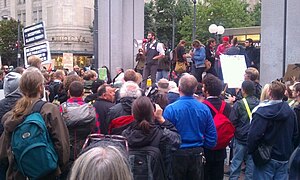
A police riot is a riot carried out by the police; more specifically, it is a riot that police are responsible for instigating, escalating or sustaining as a violent confrontation. Police riots are often characterized by widespread police brutality, and they may be done for the purpose of political repression.
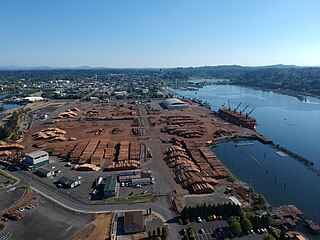
Port Militarization Resistance (PMR) is an anti-war movement in the United States. The movement began in May 2006, in Olympia, Washington, but also has chapters in Tacoma, Washington, Grays Harbor, Washington, and the Mid-Atlantic region. Port Militarization Resistance is also the name of the strategy employed by this movement. Adherents of the PMR strategy advocate an end to the Iraq War and the War in Afghanistan to be accomplished through making civilian-owned ports inaccessible to the military, with less emphasis on persuading elected officials to abandon the war. PMR organized high-profile protests at the Port of Olympia and the Port of Tacoma in 2006, 2007, 2008, and 2009.

Occupy Los Angeles was one of the many occupy movements in the United States, following the original Occupy Wall Street (OWS) protest. Participants of Occupy L.A. first met at Pershing Square on September 23, 2011. Activists came to consensus to occupy public space in solidarity with the growing movement. Occupiers first marched in Los Angeles on September 24, 2011. They next protested a fundraiser being held in Hollywood at the House of Blues for President Obama. Participants met at Pershing Square every subsequent night to plan out the logistics of an occupation set to begin on October 1, 2011. After debating potential locations around Los Angeles, people decided on the lawns around City Hall. Tents first manifested on October 1, 2011 on the grounds of Los Angeles City Hall.
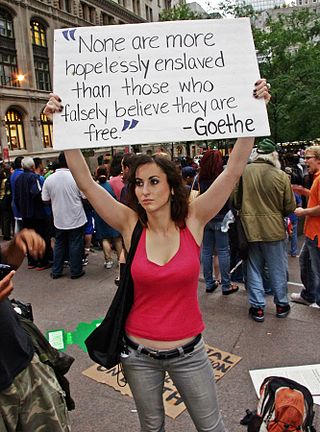
The following is a timeline of Occupy Wall Street (OWS), a protest which began on September 17, 2011 on Wall Street, the financial district of New York City and included the occupation of Zuccotti Park, where protesters established a permanent encampment. The Occupy movement splintered after NYC Mayor Bloomberg had police raid the encampment in Zuccotti Park on November 15, 2011. The timeline here is limited to this particular protest during this approximate time-frame.

Occupy Portland was a collaboration that began on October 6, 2011 in downtown Portland, Oregon as a protest and demonstration against economic inequality worldwide. The movement was inspired by the Occupy Wall Street movement that began in New York City on September 17, 2011.

Occupy San José was a peaceful protest and demonstration in City Hall Plaza in San Jose, California. The demonstration was inspired by Occupy Wall Street and is part of the larger "Occupy" protest movement. The aim of the demonstration was to begin a sustained occupation in downtown San José, the 10th largest city in the United States, to protest perceived corporate greed and social inequality, including opposing corporate influence in U.S. politics, the influence of money and corporations on democracy and a lack of legal and political repercussions for the 2007–2008 financial crisis.

The Occupy movement was an international populist socio-political movement that expressed opposition to social and economic inequality and to the perceived lack of real democracy around the world. It aimed primarily to advance social and economic justice and different forms of democracy. The movement has had many different scopes, since local groups often had different focuses, but its prime concerns included how large corporations and the global financial system control the world in a way that disproportionately benefits a minority, undermines democracy and causes instability.
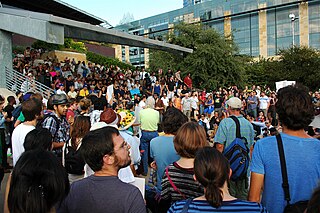
Occupy Austin was a collaboration that began on October 6, 2011 at City Hall in Austin, Texas as an occupation and peaceful protest. It is affiliated with the Occupy Wall Street movement that began in New York City, and also with the "Occupy" protests in the United States and around the world. At the center of the occupation is the General Assembly, where the community comes out and tries to come to consensus on proposals for action.
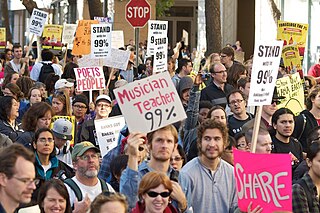
Occupy Oakland refers to a collaboration and series of demonstrations in Oakland, California, that started in October 2011. As part of the Occupy movement, protesters have staged occupations, most notably at Frank H. Ogawa Plaza in front of Oakland City Hall.

Occupy San Francisco was a collaboration that began with a demonstration event located at Justin Herman Plaza in the Embarcadero and in front of the Federal Reserve building on Market Street in the Financial District in San Francisco, California. It is based on the Occupy Wall Street movement that began in New York City on September 17, 2011 and is one of several "Occupy" protest sites in the San Francisco Bay Area; other sites include Occupy Oakland and Occupy San Jose.
Occupy San Diego was one of the many occupation protest movements in the United States. Located in San Diego, California, the protest movement initially began in the city's downtown district at the Civic Center. According to authorities, it had "a growing problem with violence and mounting trash". However this assertion was disputed by protesters and eyewitnesses, since Occupy protesters have been actively cleaning the site since October, 2011. It is based on the Occupy Wall Street movement that began in New York City on September 17 and is one of several "Occupy" protest sites in the Southern California, including Occupy Los Angeles.

The Occupy movement spread to many other cities in the United States and worldwide beginning with the Occupy Wall Street protests in New York City in September 2011. The movement sought to advance social and economic justice and different forms of democracy but each local group varied in specific aims. The demonstrations and encampment in New York City spread to other major and smaller cities. Some camps lasted through 2012. What follows is an alphabetical, non-chronological summary of Occupy encampments in the United States.
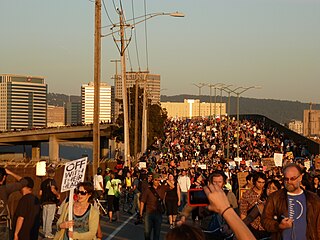
The following is a timeline of Occupy Oakland which began on Monday, October 10, 2011, as an occupation of Frank H. Ogawa Plaza located in front of Oakland City Hall in downtown Oakland, and is an ongoing demonstration. It is allied with Occupy Wall Street, which began in New York City on September 17, 2011, and is one of several "Occupy" protest sites in the San Francisco Bay Area. Other sites include Occupy San Francisco and Occupy San Jose.

The UC Davis pepper spray incident occurred on November 18, 2011, during an Occupy movement demonstration at the University of California, Davis. After asking the protesters to leave several times, university police pepper sprayed a group of student demonstrators as they were seated on a paved path in the campus quad. The video of UC Davis police officer Lt. John Pike pepper-spraying demonstrators spread around the world as a viral video and the photograph became an Internet meme. Officer Alex Lee also pepper sprayed demonstrators at Pike's direction.
The Occupy movement has been met with a variety of responses from local police departments since its beginning in 2011. According to documents obtained by the Partnership for Civil Justice Fund, the FBI, state and local law enforcement officials treated the movement as a potential criminal and terrorist threat and used fusion centers and counterterrorism agents to investigate and monitor the Occupy movement.

The city of Seattle experienced protests over the murder of George Floyd in 2020 and 2021. Beginning on May 29, 2020, demonstrators took to the streets throughout the city for marches and sit-ins, often of a peaceful nature but which also devolved into riots. Participants expressed opposition to systemic racism, police brutality and violence against people of color.

The Capitol Hill Autonomous Zone (CHAZ) or Capitol Hill Organized Protest (CHOP), originally Free Capitol Hill and occasionally the Capitol Hill Occupied Protest (CHOP), was an occupation protest and self-declared autonomous zone in the Capitol Hill neighborhood of Seattle, Washington. The zone, originally covering two intersections at the corners of Cal Anderson Park and the roads leading up to them, was established on June 8, 2020, by people protesting the May 2020 killing of George Floyd by a police officer in Minneapolis, Minnesota. The zone was cleared of occupants by police on July 1, 2020.

The Breonna Taylor protests were a series of police brutality protests surrounding the killing of Breonna Taylor. Taylor was a 26-year-old African-American woman who was fatally shot by plainclothes officers of the Louisville Metro Police Department on March 13, 2020. Police were initially given "no-knock" search warrant, but orders were changed to "knock and announce" before the raid. Taylor's boyfriend, Kenneth Walker, who was inside the apartment with her during the raid, said he thought the officers were intruders. He fired one shot, hitting officer Mattingly in the leg, and the officers fired 32 shots in return, killing Taylor.
Eugene has a long history of community activism, civil unrest, and protest activity. Eugene's cultural status as a place for alternative thought grew along with the University of Oregon in the turbulent 1960s, and its reputation as an outsider's locale grew with the numerous anarchist protests in the late 1990s. According to the Chicago Tribune, the city was called a "cradle to [the] latest generation of anarchist protesters." Occupy Eugene was home to one of the nation's longest-lasting Occupy protests in 2011, with the last protester leaving the initial Occupy camp on December 27, 2011. The city received national attention during the summer of 2020, after Black Lives Matter protests in response to the murder of George Floyd grew violent.

Dorli Rainey was an Austrian-American political activist. After being pepper-sprayed at an Occupy Seattle protest by police, she became one of the faces of the Occupy Wall Street movement.
